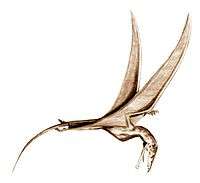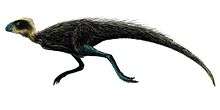Lagerpeton
| Lagerpeton Temporal range: Late Triassic, 236–234 Ma | |
|---|---|
| Scientific classification | |
| Kingdom: | Animalia |
| Phylum: | Chordata |
| Class: | Reptilia |
| Family: | †Lagerpetidae |
| Genus: | †Lagerpeton Romer, 1971 |
| Species: | †L. chanarensis |
| Binomial name | |
| Lagerpeton chanarensis Romer, 1971 | |
Lagerpeton is a genus of basal dinosauromorph. First described by A. S. Romer in 1971,[1] it includes only the species L. chanarensis.[2] This species is incompletely known with fossil specimens accounting for the pelvic girdle, hindlimbs and posterior presacral, sacral and anterior caudal vertebrae.

Description
Lagerpeton is estimated to have been 70 cm (28 in) in length based on the length of the hindlimb;[3] the most complete hindlimb specimen, from PVL 4619, measures 257.9mm from proximal femur to distal ungual.[2] Body mass has been estimated as no more than 4 kg based on the slender cross section of limb bones and estimates between more derived dinosauromorphs such as Silesaurus, and basal saurischians like Eoraptor.[4] Twenty one autapomorphic characters have been identified in L. chanarensis, these include: the anterior inclination of the posterior dorsal neural spines, the hook-shaped femoral head and the length of digit IV and metatarsal IV being greater than digit III and metatarsal III.[2] L. chanarensis lacks many dinosaurian characters, such as the anterior trochanter, placing it basal within Dinosauromorpha.[3]
Classification
Early to late Olenekian trackways from Poland have yielded footprints of a Lagerpeton-like quadrupedal dinosauromorph.[5] This ichnogenus, named Prorotodactylus shares multiple synapomorphic characters with Lagerpeton including approximately parallel digits II, III and IV, fused metatarsus, digitigrade posture and reduced digits I and V. Prorotodactylus also shares the, previously autapomorphic, pes morphology of Lagerpeton. If this ichnogenus represents a close relative of Lagerpeton it would push back the origin of this taxon to the Early Triassic; as a quadrupedal basal dinosauromorph, it also raises questions debating the theory that bipedalism is ancestral to dinosaurs.[5]
The genus Lagerpeton is currently accepted as the basalmost clade within Dinosauromorpha and the sister taxon to Dinosauriformes.[3] Presently, Lagerpeton sits within the family “Lagerpetidae”, also occupied by the more derived genus Dromomeron, known from Late Triassic rocks of the southwestern USA.[3]
Cladogram simplified after Kammerer, Nesbitt & Shubin (2012):[6]
| Ornithodira |
| |||||||||||||||||||||||||||
| |
Palaeogeography
The oldest fossils of L. chanarensis were found in the Chañares Formation and originate from the Upper Middle Triassic (Ladinian) of Southern Pangaea. All Lagerpeton specimens share this geographic location, including other fossils from the Lower Late Triassic (Carnian).[7] Radiodating of volcanic material in the formation has narrowed the formation and entire fossil assemblage found there to between 236 and 234 million years old.[8]
Locomotion
It has been suggested that the extant analogues most similar to L. chanarensis are small bipedal mammals, which are often saltators. Three morphological characteristics in L. chanarensis fossils have been putatively cited as evidence of saltation in this taxon.[2]
Neural spines
The neural spines of the posterior dorsal vertebrae are inclined anteriorly, a character not observed in any other archosaur, but common in saltatory mammals. This feature is suggested to allow for greater vertebral flexibility, correlated with leaping and bounding locomotor styles.
Pelvic girdle
Relative to the hindlimb length, the pelvic girdle is remarkably small. The distance from the pelvic girdle to the femur is therefore also small, more so than most other archosaurs apart from closely related taxa. This reduction in distance may increase the force production during hip extension in extant small mammals.
Didactyl foot
The narrow and functionally didactyl pes are a further similarity to modern saltators. By condensing into a single unit, the metatarsus gains strength without the drawback of increased weight. It also appears likely that consequently to the reduction of digit II, digit IV may have elongated to balance the pes.
The hypothesis of saltatorial locomotion is debated, however.[4] Vertebral adaptations of extant organisms exceed those seen in Lagerpeton; the sacral vertebrae of modern saltators are fused and the neural spines reduced. Furthermore, the size of the pelvic girdle and lateral digital reduction may be equally used as evidence for cursorial locomotion.
Specimens
Seven fossil specimens have so far been attributed to L. chanarensis, five of which were found in the Chañares Formation on the Northern branch of the Chañares River, La Rioja, Argentina:[2][7]
- UPLR 06 (holotype) – articulated right hindlimb
- PVL 4619 – articulated pelvis with sacrum, partial right and complete left hindlimbs
- PVL 4625 – left pelvis with left femur and articulated vertebral column (dorsal, sacral and anterior caudal vertebrae
- PVL 5000 – proximal end of left femur
- MCZ 4121 – complete left, and partial right, femur.
The two remaining specimens were collected from the Chinle Formation, Colorado, USA and the Ischigualasto Formation; they consist of femora and a femur respectively.[7]
References
- ↑ Romer, A. S. (1971). "The Chanares (Argentina) Triassic reptile fauna. X. Two new but incompletely known long-limbed pseudosuchians.". Breviora. 378: 1–10.
- 1 2 3 4 5 Sereno, P. C.; Arcucci, A. B. (1994). "Dinosaurian precursors from the Middle Triassic of Argentina: Lagerpeton chanarensis.". Journal of Vertebrate Paleontology. 13: 385–399. doi:10.1080/02724634.1994.10011522.
- 1 2 3 4 Nesbitt, S. J.; Irmis, R. B.; Parker, W. G.; Smith, N. D.; Turner, A. H.; Rowe, T. (2009). "Hindlimb osteology and distribution of basal dinosauromorphs from the Late Triassic of North America.". Journal of Vertebrate Paleontology. 29 (2): 498–516. doi:10.1671/039.029.0218.
- 1 2 Fechner, R. (2009). "Morphofunctional evolution of the pelvic girdle and hindlimb of Dinosauromorpha on the lineage to Sauropoda.". lmu.
- 1 2 Brusatte, S. L.; Niedźwiedzki, G.; Butler, R. J. (2011). "Footprints pull origin and diversification of dinosaur stem lineage deep into Early Triassic.". Proceedings of the Royal Society B: Biological Sciences. 278 (1708): 1107–1113. doi:10.1098/rspb.2010.1746. PMC 3049033
 . PMID 20926435.
. PMID 20926435. - ↑ Kammerer, C. F.; Nesbitt, S. J.; Shubin, N. H. (2012). "The First Silesaurid Dinosauriform from the Late Triassic of Morocco". Acta Palaeontologica Polonica. 57 (2): 277. doi:10.4202/app.2011.0015.
- 1 2 3 Langer, M. C.; Nesbitt, S. J.; Bittencourt, J. S.; Irmis, R. B. (2013). "Non-dinosaurian Dinosauromorpha.". Geological Society, London, Special Publications. 379. doi:10.1144/sp379.9.
- ↑ http://www.sciencedaily.com/releases/2015/12/151207164034.htm



